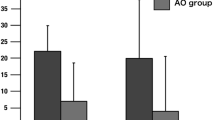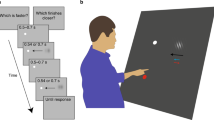Abstract
It has been suggested that movements to visible or remembered targets are differently sensitive to the Müller-Lyer (ML) illusion. Indeed, when the target is continuously visible, movements rely on the veridical object characteristics, whereas remembered movements are thought to reflect the perceived characteristics of the object. The aim of the present study was to determine how movements to visible or remembered targets are influenced by the ML illusion in children aged 7 to 11 years old. Participants were asked to make a perceptual judgment or to point a shaft extremity of the ML configurations (Closed, Control, and Open) in three visual conditions (Closed Loop, Open Loop-0-s delay, and 5-s delay). Perceptual (Perceived Length, PL) and motor (Movement Magnitude, MM, and Peak velocity, PV) variables were measured. Results showed that PL was influenced to the same extent by the ML illusion in the three visual conditions. Moreover, it appears that in subjects as young as 7 years old, the activation of the ventral system features may give rise to the perceptual illusion effect observed in all three experimental conditions. However, regardless of the subject's age, MM and PV were only sensitive in the delay condition, suggesting that delayed movements are also mediated by the ventral stream. These data suggested that the distinction between perception and motor visual pathways appears quite early during childhood (before 7 years). Our data also demonstrated that children were relying on both visual processing streams during perceptual as well as visuomotor tasks during remembered movements.

Similar content being viewed by others
References
Donkelaar PV (1999) Pointing movements are affected by size-contrast illusions. Exp Brain Res 125:517–520
Elliott D, Madalena J (1987) The influence of premovement visual information on manual aiming. Q J Exp Psychol 39A:541–559
Gentilucci M, Chieffi S, Daprati E, Saetti MC, Toni I (1996) Visual illusion and action. Neuropsychologia 34(5):369–76
Gentilucci M, Benuzzi F, Bertolani L, Gangitano M (2001) Visual illusions and the control of children arm movements. Neuropsychologia 39:132–139
Haffenden AM, Goodale MA (1998) The effect of pictorial illusion on prehension and perception. J Cog Neurosc 10:122–36
Hanisch C, Konczak J, Dohle C (2001) The effect of the Ebbinghaus illusion on grasping behaviour of children. Exp Brain Res 137:237–245. DOI 10.1007/s002210000655
Kovàcs I (2000) Human development of perceptual organization. Vis Res 40:1301–1310
Milner AD, Goodale MA (1995) The visual brain in action (Oxford Psychology Series, 27). Oxford University Press, Oxford
Piaget J (1961) Les mécanismes perceptifs. Presses Universitaires de France, Paris
Westwood DA, Chapman CD, Roy EA (2000a) Pantomimed actions may be controlled by the ventral visual stream. Exp Brain Res 130:545–548. DOI 10.1007/s002219900287
Westwood DA, Heath M, Roy EA (2000b) The effect of a pictorial illusion on closed-loop and open-loop prehension. Exp Brain Res 134:456–463. DOI 10.1007/s002210000489
Wraga M, Creem SH, Profitt DR (2000) Perception-action dissociations of a walkable Müller-Lyer configuration. Psychol Science 11(3):239–243
Acknowledgements
The authors are grateful to the children and parents for their precious collaboration. Special thanks to Yves Rossetti (CNRS, INSERM, Lyon, France) for helpful comments on earlier versions of this manuscript.
Author information
Authors and Affiliations
Corresponding author
Rights and permissions
About this article
Cite this article
Rival, C., Olivier, I., Ceyte, H. et al. Age-related differences in a delayed pointing of a Müller-Lyer illusion. Exp Brain Res 153, 378–381 (2003). https://doi.org/10.1007/s00221-003-1559-5
Received:
Accepted:
Published:
Issue Date:
DOI: https://doi.org/10.1007/s00221-003-1559-5




